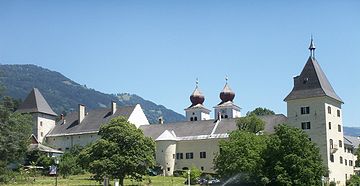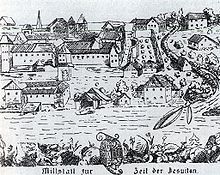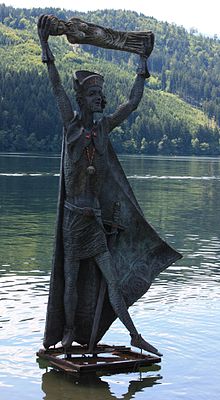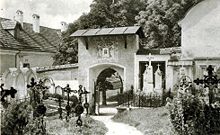- Millstatt Abbey
-
Millstatt Abbey from the west, with the Central Eastern Alps in the background

Millstatt Abbey (German: Stift Millstatt) is a former monastery at Millstatt in the Austrian state of Carinthia, which was established about 1070 and finally abolished in 1773.
For centuries the monastery was the spiritual and cultural centre of Upper Carinthia and with its possessions around the Millstätter See, in the Görtschitz valley (Brückl) as well as in the former March of Friuli and in the Archbishopric of Salzburg (Pinzgau), one of the largest in the province.
Contents
History
Millstatt Abbey was founded as a proprietary monastery by the Chiemgau count Aribo II (1024–1102), a scion of the Aribonid dynasty and former Count palatine of Bavaria, and his brother Poto on their estates in the Duchy of Carinthia. Though no charter is preserved, a later chronicle mentions a tithe agreement from about 1070 between Aribo, who then held two churches at Millstatt, and Archbishop Gebhard of Salzburg. As Bishop Gebhard during the Investiture Controversy was exiled by King Henry IV in 1077, it is presumed that the foundation took place in the time period before. The monastery had definitely been established before 1122, when it was mentioned in a deed issued by Pope Callixtus II. It was then run by Benedictine monks, who may had descended from Hirsau Abbey. The first verified abbot around 1122 however was a former prior of Stift Admont in Styria, an abbey which had also been established by Archbishop Gebhard. The Meinhardiner counts of Tyrol, also Dukes of Carinthia from 1286, held the office of a Vogt until the extinction of the line in 1369.
The abbey prospered during its early years, enjoying special papal protection, again confirmed by Pope Alexander III in a 1177 deed; it was however never officially exempt and remained under the overlordship of the Archbishops of Salzburg. The premises included an adjacent nunnery and a well-known scriptorium, where the Benedictine monks left numerous manuscripts, though the most famous Middle High German Millstätter Handschrift (Millstatt Manuscript) probably did not originate here. The abbey even included a nunnery, which was dissolved in the 15th century. In 1245 the abbot of Millstatt even received the pontifical vestments from the Salzburg Archbishop.
At the same time however, the long decay of the Benedictine monastery began, enhanced through the confusion in the Empire after the ban of the last Hohenstaufen Emperor Frederick II and the struggles of the Meinhardiner with the rising Habsburgs, who finally were vested with Carinthia upon the death of Duke Henry VI in 1335. From the Meinhardiner, the Vogt office passed to the Counts of Ortenburg, it was inherited by Count Hermann II of Celje in 1418. When his grandson Count Ulrich II of Celje was killed in 1456, all his possessions and titles including the Vogtei of Millstatt finally fell to Frederick III of Habsburg, Holy Roman Emperor since 1452.
At this time the convent comprised only about ten monks; Emperor Frederick found the morals degenerated, the buildings decayed and the abbot inept. He travelled to Rome and on 1 January 1469 reached a papal bull by Pope Paul II, whereby he established the military order of the Knights of Saint George in order to fight the invading troops of the Ottoman Empire. Against the protest by the Salzburg Archbishop, the order was vested with the buildings and assets of Millstatt Abbey, while the Benedictine monastery was disestablished with the handover cerenomy of May 14.
 Millstatt Abbey, Valvasor, 1688
Millstatt Abbey, Valvasor, 1688
The grand master however commanded only few knights, who had to cope with the enormous debts left by the Benedictines and the redevelopment of the neglected premises. The order was therefore fully engaged with the fortification of the monastery, while they failed to protect the region: Millstatt was heavily devastated by the Turks on their 1478 campaign, followed by the Hungarian troops of Emperor Frederick's long-time rival Matthias Corvinus in 1487. Frederick's son Maximilian I, the "Last Knight", again was a promoter of the order, however the time for the mediæval chivalric institution was up. The power of the order declined, leading to unrest among the surrounding peasants revolts and the spread of the new Protestant belief. The last grand master did not even reside at Millstatt and from 1541 onwards the estates were under the rule of Inner Austrian administrators and given in pawn several times.
In 1598 Archduke Ferdinand II of Inner Austria vested the Society of Jesus at Graz with Millstatt. In the course of the Counter-Reformation, the Jesuits built up a college at the Styrian capital (the present-day University of Graz), that was to be financed with the income of the Millstatt estates. The monks soon became disliked by the local population for their stern measures to lead the subjects back to the Catholic confession and especially for their unyielding enforcement of public charges. In 1737 the displeasure culminated in open revolt, when numerous peasants ganged up and stormed the monastery. Remote valleys remained centres of Crypto-protestantism. The rule of the Jesuits came to a sudden end, when the order was suppressed by Pope Clement XIV in 1773. The monks had to leave Millstatt and their estates passed to the public administration of the Habsburg Monarchy.
Domitian legend
According to a tradition given by the Benedictine monks which was already documented in the 12th century, the monastery traces back to the (second) Christianization of the area about 780, then under the rule of one Slavic duke Domitian. Legend has it, that Domitian's son drowned in a storm on Millstätter See, whereafter his father had himself baptized, ordered the first church to be built at Millstatt where the dead body was found, and threw a thousand of graven statues - mille statuæ - compiled at a pagan temple into the lake in holy wrath.
Indeed present-day Carinthia was part of the Early Mediæval prinicipality of Carantania, which comprised Slavic tribes settling the Eastern Alps from the late 6th century onwards, however a Duke Domitian is not mentioned in contemporary chronicles like the Conversio Bagoariorum et Carantanorum. On the other hand several artifacts found in and around the monastery dating back to the Carolingian period indicate that a church already existed at Millstatt in the late 8th century, after the region had been Christianized by Chorbishop Modestus sent by Bishop Vergilius of Salzburg.
In any case the legend was useful for the monks of Millstatt to emancipate themselves from the Aribonid founders of the abbey; centuries later the Jesuits strongly referred to the myth in order to strengthen the popular devotion in the course of the Counter-Reformation. They however failed to have Domitian canonized by the Holy See. In Millstatt his feast day is still celebrated on February 5.
Buildings
Since 1977 the church is a property of the local parish of the Gurk diocese, while all other buildings of the former abbey belong to the Austrian state and are administrated by the Austrian State Forestry Commission (Österreichische Bundesforste).
Sources
- Schroll, Anton, 2001: Dehio-Handbuch. Die Kunstdenkmäler Österreichs. Kärnten, pp. 536–548. Vienna. ISBN 3-7031-0712-X
- Weinzierl, Erika, 1951: Geschichte des Benediktinerklosters Millstatt in Kärnten (Archiv für vaterländische Geschichte und Topographie, vol. 33). Verlag des Geschichtsvereines für Kärnten: Klagenfurt. (no ISBN)
External links
- Millstatt.at: Description of the abbey church (German)
- Stiftsmuseum Millstatt (German)
Coordinates: 46°48′15″N 13°34′15″E / 46.8041666667°N 13.5708333333°E
Categories:- Benedictine monasteries in Austria
- Buildings and structures in Carinthia
- Society of Jesus
- Christian monasteries established in the 11th century
Wikimedia Foundation. 2010.




